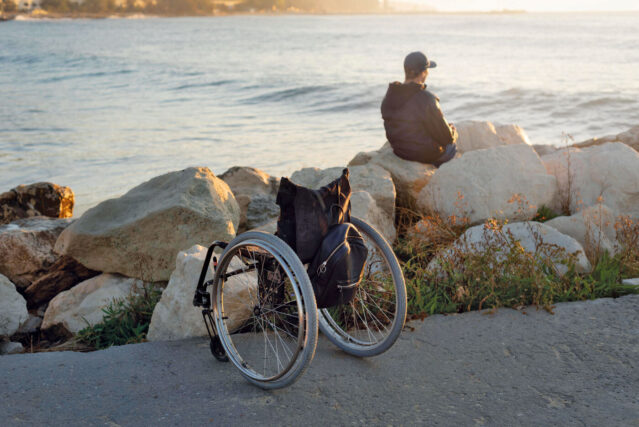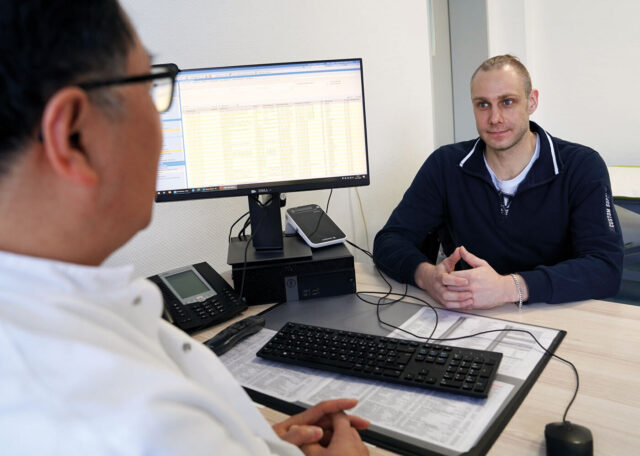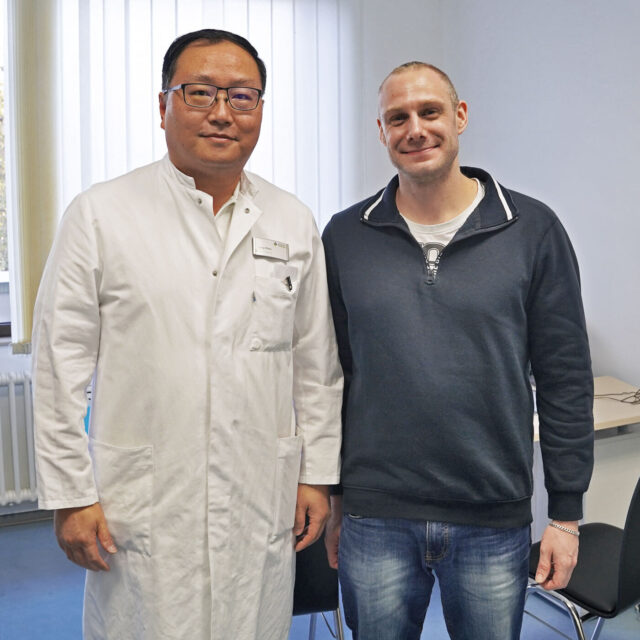Bye wheelchair!
How a patient got back on his feet after pain, despair, and hope

Photo: freepik.com
Have article read aloud
Vom aktiven Kampfsportler hin zu einem Patienten mit schweren chronischen Schmerzen und gravierenden Rückenproblemen – in den vergangenen Jahren musste Jan Plomann tiefgreifende Veränderungen in seinem Leben bewältigen. Was mit einem leichten Ziehen im Rücken und gelegentlichen Beschwerden begann, entwickelte sich zu massiven Schmerzen und einem Leben im Rollstuhl. Die Ursache seiner Beschwerden: Eine angeborene Spondylolisthesis, auch bekannt als Wirbelkörpergleiten. Nach mehreren Operationen in anderen Krankenhäusern fand er erst bei Liang Zhou, Leitender Arzt der Speziellen Wirbelsäulenchirurgie im Deutschen Wirbelsäulen- und Skoliosezentrum der Sportklinik Hellersen, die medizinische Betreuung, die er sich gewünscht hatte.
From active martial artist to patient with severe chronic pain and serious back problems – Jan Plomann has had to cope with profound changes in his life in recent years. What began with a slight pulling sensation in his back and occasional discomfort developed into severe pain and a life in a wheelchair. The cause of his complaints: congenital spondylolisthesis, also known as vertebral slippage. After several operations in other hospitals, it was only at the German Spine and Scoliosis Center at the Sportklinik Hellersen that he found the medical care he had been looking for in Liang Zhou, Senior Physician in Special Spinal Surgery.
Video: Bye wheelchair!
What is spondylolisthesis?
Spondylolisthesis, also known as vertebral slippage, is a condition of the spine in which one vertebra slips forward over the vertebra below it. This malformation or instability can be congenital, develop due to degenerative changes with age, or be caused by excessive strain, injury, or accidents.
Typical symptoms include back pain, which often radiates into the legs, restricted movement, muscle tension, and weakness in the legs. In severe cases, nerve damage or even paraplegia may occur.
In 2019, Jan Plomann, a 28-year-old man, began a painful and difficult period full of unexpected challenges. As a fit and active person, he spent his free time training extensively in martial arts. However, the first symptoms appeared after he suffered an umbilical hernia during a training match. He had already noticed occasional pain and a pulling sensation in his back. It also turned out that a mesh implanted after a previous hernia had torn and was pinching a nerve and the spermatic cord.
The combination of these injuries led to significant restrictions in movement – a condition that made it impossible for him to continue playing sports or performing the stretching exercises that were so important to him. This contributed to a steady deterioration in his physical condition. Only after thorough examinations was he finally diagnosed with congenital vertebral slippage – a rare malformation that caused severe symptoms in his case.
“Vertebral slippage is a malformation in which the structure of the vertebral body is separated. Under stress, such as from sports or long-term strain, the affected vertebral body slips forward. This causes the nerve roots to move along with it, while the intervertebral disc is pushed backward. This displacement can irritate or pinch the nerves, resulting in severe pain and restricted movement,” explains Liang Zhou, Leading Senior Physican in Specialized Spinal Surgery.

However, the first operation, performed at a hospital in Switzerland, did not provide complete relief: the torn mesh in his groin, a splinter in his knee, and the lack of physical therapy prevented him from doing the necessary exercises for his back. “I later learned that apparently not enough space had been left for the spinal canal during the operation. This complication led to the development of spinal stenosis, which ultimately required a second back operation,” reports Jan Plomann.
In December 2021, he underwent a second back operation at another hospital, during which a fixation was performed. Although he felt relief from the chronic nerve pain after the procedure, especially in his left leg, the numerous operations—four in total within a year—took a heavy toll on his body. In addition to the two back surgeries, he also required procedures on his groin and navel, which further limited his mobility.
“The doctors took the time to get to know me as a person and to take a close look at my condition. I am eternally grateful to them for that.”
Patient Jan Plomann
What is spinal stenosis?
Spinal stenosis is a narrowing of the spinal canal, which contains the spinal cord and nerves. This narrowing puts pressure on the nerves, which can cause various symptoms. The most common causes are degenerative changes such as osteoarthritis or disc degeneration, bone spurs, thickened ligaments, injuries, or congenital malformations.
Typical symptoms include back pain that often radiates into the legs, tingling, numbness, or weakness in the extremities. Many sufferers report pain that increases when walking or standing, while the symptoms can often be relieved by bending forward or sitting down.
After the operation, the young man was still confined to a wheelchair and suffered from severe pain that made any movement almost impossible. Several falls and open wounds documented his desperate attempt to lead a normal life. It was only when he arrived at the Sportklinik Hellersen that he felt taken seriously for the first time. “The doctors took the time to see me as a person and to take a close look. I am eternally grateful to them for that,” he emphasizes.
The patient was first examined in detail in the Special Spinal Surgery Department of the German Spine and Scoliosis Center at the Sportklinik Hellersen. ”The patient's condition was extremely critical. The muscles in both legs had completely atrophied and he had no strength whatsoever. From a clinical point of view, he was paraplegic,” reports the senior physician. To determine the cause of the paraplegia, Jan Plomann was first referred to a neurologist to rule out neurological disorders. However, all the tests carried out, including magnetic resonance imaging and electronic diagnostics, did not reveal any significant findings that could explain the paraplegia. “After the second operation, the disc replacement and the upper and rear screws were loose. The rear structure of the vertebral body had been removed, leading to complete instability of the anterior segments. The implants failed after the second operation, which we identified as the main cause of the symptoms and which necessitated further surgery,” explains Liang Zhou. During the procedure, the implants and the disc replacement were replaced.
“The patient's condition was extremely critical. The muscles in both legs were completely atrophied and he had no strength whatsoever. From a clinical point of view, he was paraplegic.”
Liang Zhou
Leading Senior Physican Special Spine Surgery
During the procedure, the implants and the disc replacement were successfully replaced.

After the operation, the patient felt the first signs of improvement. In particular, the persistent nerve pain that had previously affected his left leg subsided. But the road to recovery was rocky. A subsequent infection led to further hospital stays, antibiotic treatments, and renewed surgery. Shortly thereafter, he suffered an intestinal obstruction, which set him back again. “I just didn't want to go on anymore. My body was at the end of its rope, inflamed, exhausted. If someone had told me that I could break down like that, I wouldn't have believed them,” he reflects.
Despite this difficult time, he fought his way back to life. Jan Plomann was already able to walk with the aid of crutches when he attended his first follow-up appointment. The back pain had subsided significantly and the muscles in his legs were beginning to rebuild. “Of course, there are still limitations—I'll probably never fight again. But I'm grateful that I can stand and walk.” Lifting weights remains particularly problematic; even a few kilograms can cause severe pain. But through patience, acceptance, meditation, and the support of his family and friends, he has learned to live with the limitations.



























